VOTE LIVANOS - Alpine Club
Le Grec et Sonia ont toujours été des inconnus en Grande-Bretagne et même si pour beaucoup Au delà de la verticale fait partie des meilleurs livres de montagne écrits en français au même titre que Premier de cordée, Annapurna premier 8000 et Les Conquérants de l'inutile, il n'a jamais été traduit en anglais.
A force de raconter Le Grec et Sonia à mes amis de l'Alpine Club, j'ai déclenché chez eux le désir d'en savoir plus et l'éditeur de l'Alpine Journal (publication annuelle de 400 à 440 pages), Ed Douglas, excellent alpiniste, journaliste et écrivain, a fini au bout de trois ans par me persuader d'écrire un article sur le Grec et Sonia. Je ne suis pas écrivain, même si j'écris des articles de montagne, parfois historiques, en anglais sur le site Summitpost, et j'avais très peur de ne pas être à la hauteur du Grec et de Sonia. Mais je ne pouvais plus me dérober d'autant plus que je suis convaincu que les alpinistes britanniques ne pourront qu'aimer Le Grec et Sonia, ne serait-ce que par l'humour du Grec, largement digne de celui de Don Whillans et par le féminisme conquérant de Sonia digne aussi de celui de Néa Morin et de Briggsy (la comtesse Gravina, compagne de Claude Cogan au Cho Oyu où elle décédera dans une avalanche). Et puis cela ne pourrait que favoriser une édition en anglais d'Au delà de la verticale.
Voilà, l'article est publié dans la version 2020 de l'Alpine Journal (décembre 2020) et Ed a eu la délicatesse de ne pas trop raccourcir mon texte. En fait c'est un des articles les plus longs publiés par l'Alpine Journal, 16 pages, alors qu'en moyenne ils ne doivent pas dépasser 8 pages. Un hommage très net donc de nos amis alpinistes britanniques.
J'espère que les lecteurs aimeront cet article, même si je sais bien que d'autres ont des talents tellement plus grands (comme Barney par exemple qui en plus avec sa femme Jacky étaient aussi fan du Grec et de Sonia que moi) qu'ils auraient surement fait beaucoup mieux. En tout cas je crois qu'aucun n'a été plus "fan" du Grec et de Sonia que moi et que cela se verra en lisant cet article en hommage au Grec et à Sonia.
Bonne lecture
ERIC VOLA
‘Vote Livanos!’
The Life and Times of a Marseille Legend
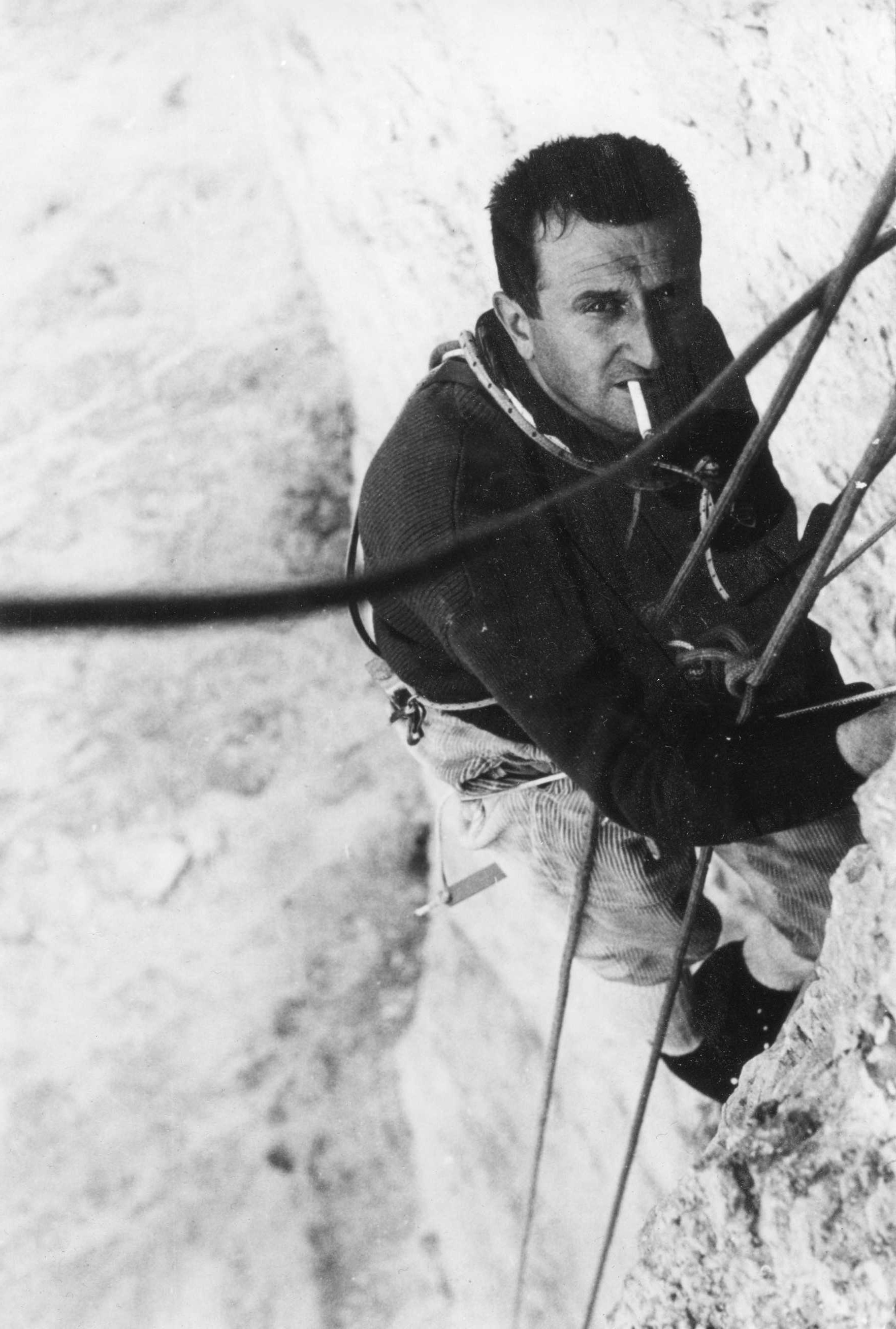
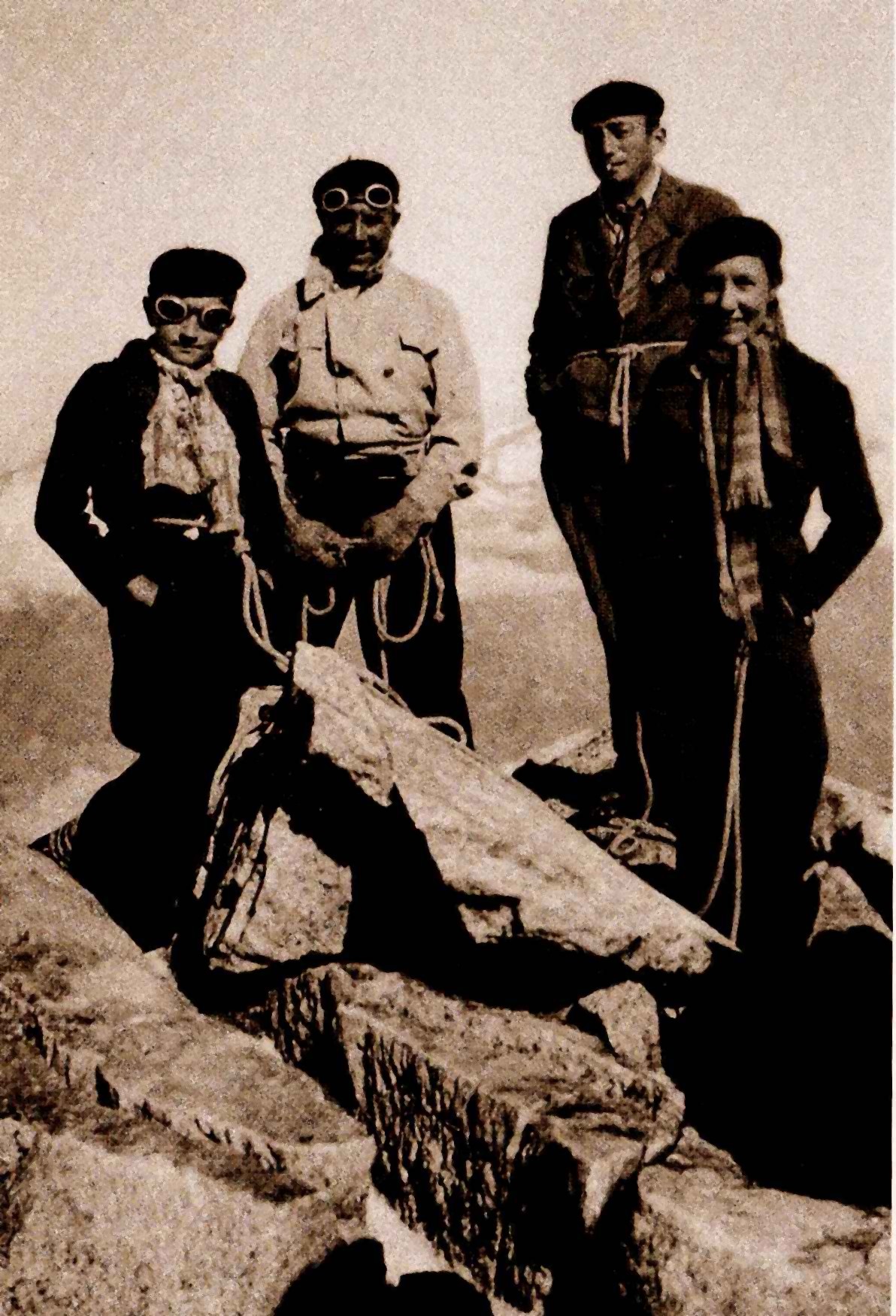
'VOTE LIVANOS' 153
He was as good as his word. The following year he was writing again to Devies, then in his last year editing La Montagne et Alpinisme, house magazine of the GHM and the French Alpine Club. Le Grec told Devies that he had completed the line, ‘a beautiful, unbelievably beautiful route and even more, it is one of the “moments” of my life.’ It was, he told Devies, his 53rd new route in the Alps. ‘What a present for my 50th birthday!’ The summit they reached had never been climbed before. ‘Now it is the Punta Constantini: 650m, ED, 90 pegs, two bivouacs and 12 abseils to come down.’ He had almost burst with joy, he told Devies, but
… a deep joy which brought peace to me, which I offered to Gianni and to Germana, his wonderful spouse; this route, she wanted it as much as I did. She came to Vazzoler, the day before, with her little Michele (15 months old), she wanted to be there, to participate, encourage me maybe. Encourage me? An SS division would not have stopped me! I lived one full year solely waiting for that moment, that summit day.
Both Le Grec and Don Whillans were true greats with respect for other climbers from new as well as older generations. If there is a climbers’ paradise it may well be that they are having a battle of wits to the benefit of all present, because as everyone knows there is no language barrier in heaven. There will be others gathered round. Many of the great names of alpinism tied onto a rope with Le Grec, particularly when they came to the Calanques: Jean Franco, Maurice Herzog, Lionel Terray, Gaston Rébuffat, Jean Couzy, Michel Vaucher, Claudio Barbier, not to mention his Italian friends, Gino Soldà, Armando da Roit, Beppi de Franchesch, Marcello Bonafede, Ménégus, Stenico and many others. Not that he was overawed by another’s reputation. Far from it. In a freewheeling interview from 1984 with Bernard Amy and Pascal Sombardier for Montagnes magazine, Le Grec was asked about that other great alpinist from Marseille, Gaston Rébuffat.
Ah, him, he did well. He never did anything exceptional, but he was a very complete chap: not brilliant, but safe. I liked climbing with him for that reason. With him, we were 100% sure to get to the top. As the guys climbing with me knew … well, a 98% chance. There were more brilliant guys with whom I’d never have teamed up.
Where did he get this confidence? Maybe it was the city that nurtured him. Born in 1923 to a Greek father and a Greek grandfather, Le Grec was one hundred per cent Marseille, a city like no other in France, full of swagger and historically diverse. A third of its inhabitants are of Italian descent, alongside Corsicans, Greeks, Armenians and more recent arrivals from the Maghreb. Le Grec loved to play his own part in the city’s legend, one of colour and humour at its best.
He was the only child of loving parents. His father, Ulysse, a coffee broker, regularly took his wife, Marguerite, and their son Georges to the mountains, staying in hotels in Chamonix, in Ailefroide or in La Chapelle-en-Valgaudemar.
So Le Grec did not start climbing in the Calanques but in the Alps and specifically the Mont Blanc range. At age 13, Georges climbed his first summit, the Aiguille du Tour, with his parents and the guide Alfred Burnet. In the following two summers, his father hired Ulysse Simond to guide Georges on classic easy routes. Georges was talented enough as a rock climber to be selected by Armand Charlet during the Fête des Guides in 1938 to demonstrate how to climb the Grande Arête on the Gaillands crag. He was then 15 years old.
Back in Marseille, climbing now obsessed him. His parents made sure Georges joined the CAF in 1939. If the boy were determined to climb, it would be in the company of known personalities and alpinists they had met and climbed with in Chamonix: the Marquise d’Albertas and Jean Save de Beaureceuil, both members of the GHM. His parents asked them not to let him take the lead but it wasn’t long before Le Grec would disobey his father, as he wrote in his memoir Au-delà de la Verticale:
… one day, our leader failed on a pitch because of a bruised wrist; he came down and asked me to go and fetch the peg he had left. Reaching the peg, I saw above me beautiful grey slabs… too tempting. Madame d’Albertas saw what I was up to only as I finished the pitch. She was a little worried, not that much though, as in the ‘gang’ everyone was more or less leading and my father’s fears made them smile. It was one of the great joys of my life.
Soon Georges was adding new routes and the legend was born: in 1941 he put up 24 of which La Centrale was the longest grade six in the Calanques and the Yellow Wall, climbed with Gaston Rébuffat, was the toughest aided climb for quite some time. In 1942, he climbed 28 new routes, of which the highlight was the second ascent of Pilier de Bertagne, dubbed the Walker Spur of the Marseillais and only just climbed by Robert and Suzanne Tanner. (Le Grec considered Robert as the best climber he had known, but unfortunately Robert stopped soon afterwards.) Georges then added his own new route to its left, La Plaque.
In April 1943, he joined the Camps de Jeunesse et Montagne, as Le Grec put it 'an ersatz military service in an ersazt time'. Already this year he had done 15 new routes and become the best climber in the Calanques, by far.
154 THE ALPINE JOURNAL 2020
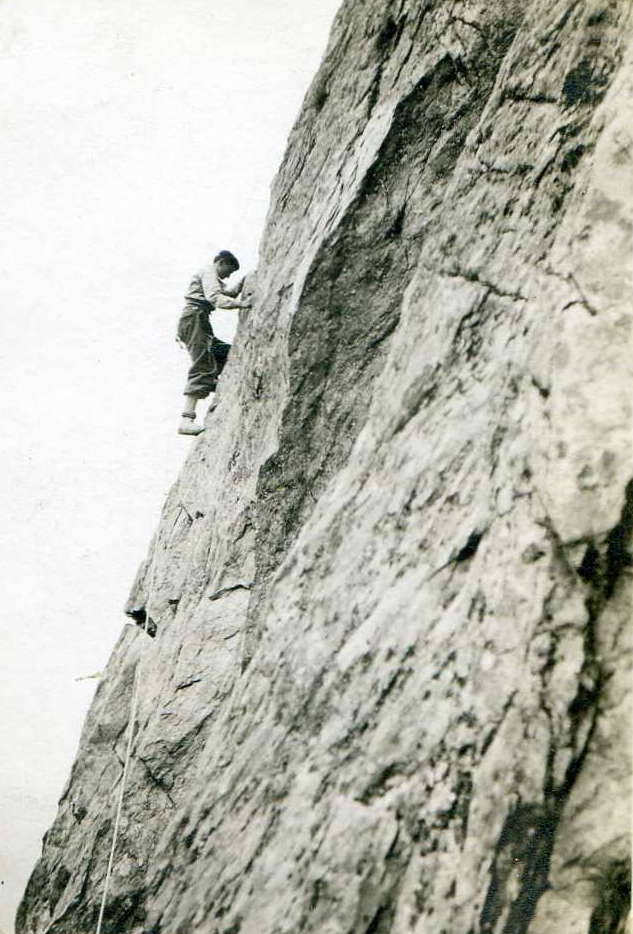
Demonstrating the Grande Arête at Les Gaillands for Armand Charlet during the Fête des Guides in 1938.
'VOTE LIVANOS' 155
Georges was lucky in his new role. His parents had needed to work hard to keep him from being one of the six hundred thousand French workers recruited to work for the Nazis in Germany under the Service du Travail Obligatoire. As Le Grec put it:
Winter having arrived, I had just done my first ski descents when I was appealed to in the most pressing manner by the Nazi regime to participate in some work in Germany. It was indeed flattering to think that my modest assistance was thought essential to the triumph of Hitler’s war effort but though deeply honoured by this invitation, I thought it better to decline.
The Calanques remained close to his heart, but as a young man in postwar Marseille climbing wasn’t so easy. In contrast to today’s ‘professionals’ and young athletes, he could only climb at the weekend, which in his heyday started on Saturday afternoons, or else during his summer holidays, which were a maximum of four weeks. In the 1950s, there was no 35-hour working week or five-week allowance, plus public holidays. Le Grec called himself a ‘Sunday’ climber, not a sportsman, not compared to those who in his old age were climbing the eighth grade. He also relied on public transport. He never learned to drive just as he never learned how to swim (for a Marseille man that really was taking the biscuit). So to climb on the Bertagne peak, 30km and an hour’s drive away, he and his friends would take the tramway to Aubagne, then the bus to Gémenos before walking to the foot of the wall. To go to Chamonix, he took the train. For places like the Vercors, he used his Vespa, the same vehicle he relied on for his work as a sales rep for a printing materials company. Using the moped he travelled up and down the Bouches du Rhône, the Var and Vaucluse. When his pal Robert Gabriel stopped climbing in 1956, he started climbing with Marc Vaucher who had a Citroën DS. Only then did he discover the comfort and convenience of a car.
Altogether Le Grec climbed 500 new routes in the Calanques of Marseille but his home crags were always a springboard to go further: to big walls, to the mountains. At the end of the war, in September 1945, his mother managed to get him a place on a mountain camp in Ailefroide. (As he wrote, ‘contrary to most mothers, mine always encouraged my passion for mountaineering, which allowed her to be my mother a second time.’) This gave him a season in the Oisans, climbing the south face of La Meije with Albert ‘Pépé’ Ouannon, his first serious mountain route, as well as the west ridge of the Pic Sans Nom and the third ascent of the south pillar of Barre des Écrins, the latter with Jean Franco and Gudérian at a blistering pace: four hours from the bergschrund to the summit. The following year he was back in Chamonix, making the second ascent of the Grand Dru’s south face and the fifth of the north face of the Grand Charmoz, both with Charles Magol, and an attempt on the west face of the Dru that was ended by stonefall. In 1947, he was part of a four-man team that made the first ascent of the Grépon’s west face, as well as the second ascent of the Requin’s north face.
156 THE ALPINE JOURNAL 2020
On the key traverse of the Cassin on the Cima Ovest, shortly after encountering Hans Lobenhoffer. Livanos made the tenth ascent, announcing his arrival. (Robert Gabriel)
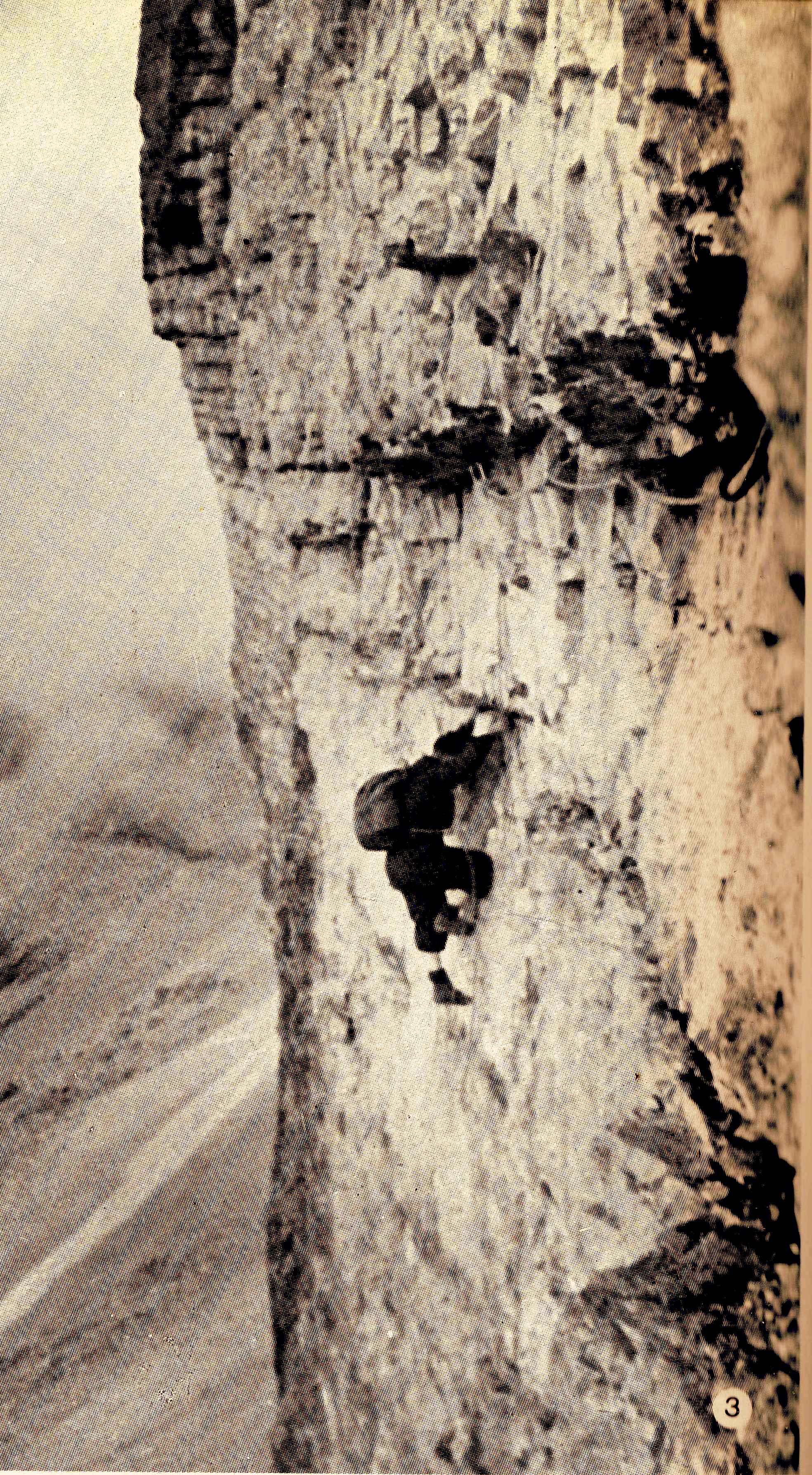
That summer was the first season he climbed with Robert Gabriel, who would become his regular partner for the next few years as he and Le Grec switched focus from the western Alps to the Dolomites. Gabriel wrote a foreword for Le Grec’s climbing memoir Au-delà de la Verticale, ‘Beyond the Vertical’, published in 1958 after they stopped climbing together, that gives some idea of the power of their friendship.
I gained a great deal from knowing him. Without Le Grec I would never have gone so far. There is no
doubt about it: Georges Livanos was a leader. I had a confidence in him that was almost blind. So much so that if I was climbing with someone else, I felt somehow embarrassed. Climbing together, each move one of us made followed the other with perfect synchronisation; we never needed to exchange words, the rope was tight or slack just at the right moment. … Always very cheerful, totally a southern man, it was a pleasure to listen to his jokes and his tales. Even during our darkest bivouacs, he was ready for a laugh, and his sheer presence generated optimism.
Having made the second ascent of the north-east face of the Aiguille de Leschaux in 1949, the pair switched the following year to the Dolomites, the start of a love affair that would last the rest of Le Grec’s career. That first summer they started with a masterpiece, making the tenth ascent of the Cassin route on the Cima Ovest. Following behind them was Hans Lobenhoffer, who had been on the German expedition to Nanga Parbat in 1939 with Heinrich Harrer and was afterwards imprisoned by the British. Seeing the crucial traverse pitch, Lobenhoffer, by then in his mid 30s, asked to tie into the French team. They were happy to oblige but then Gabriel handed Lobenhoffer the rucksack, making him their porter, before delicately picking his way across the traverse like a ballet dancer. You have to keep an eye on climbers from Marseille.
'VOTE LIVANOS' 157
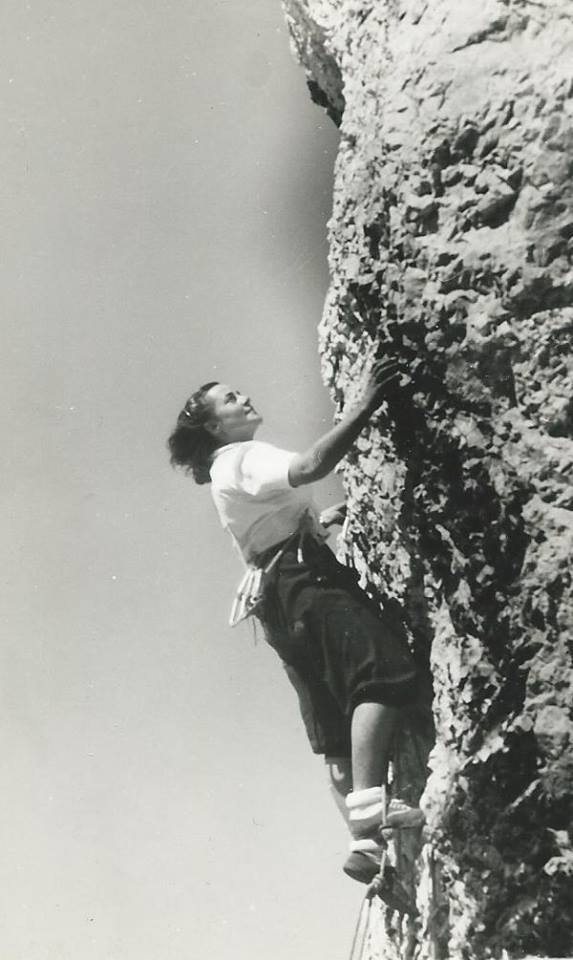
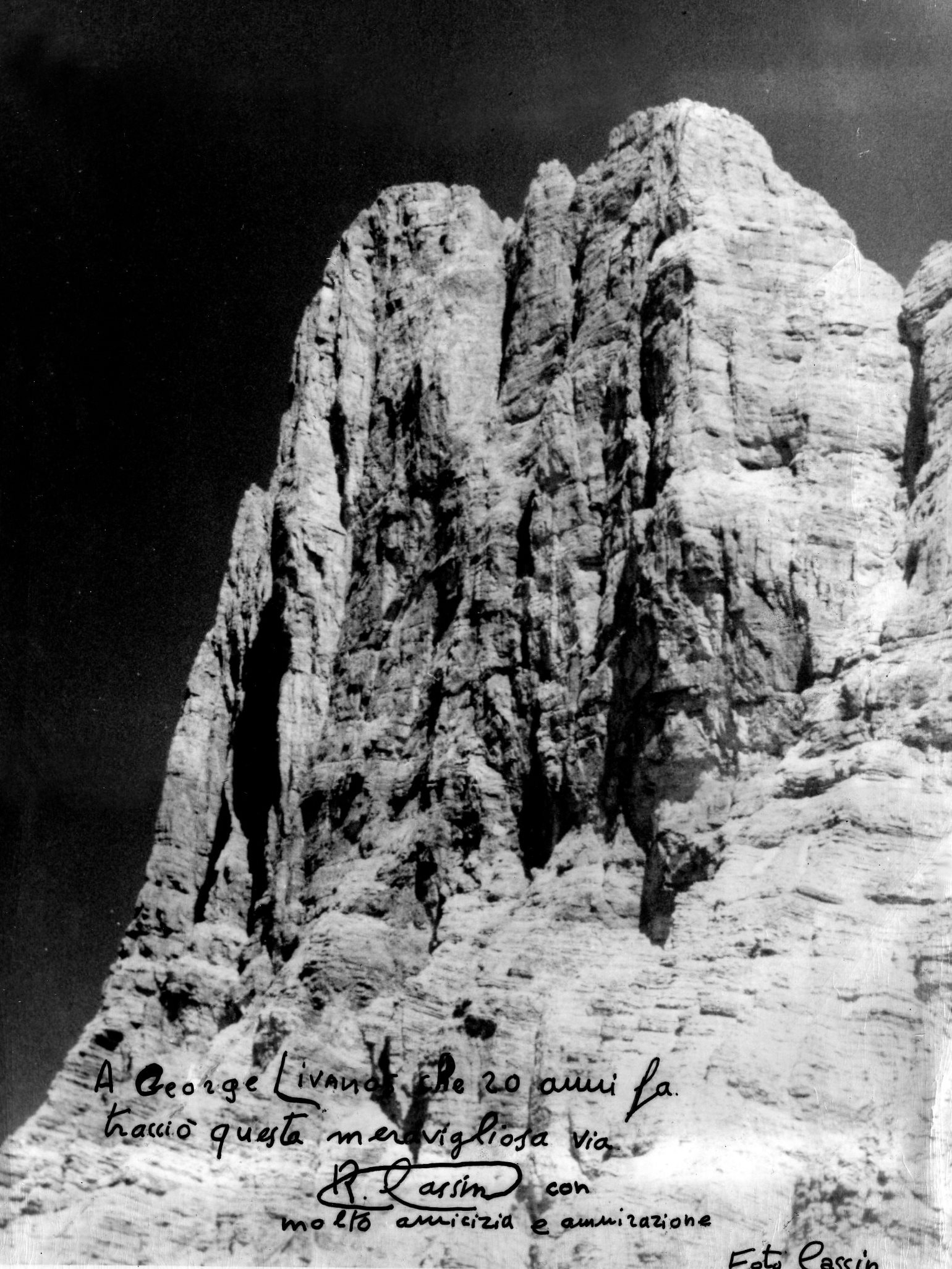
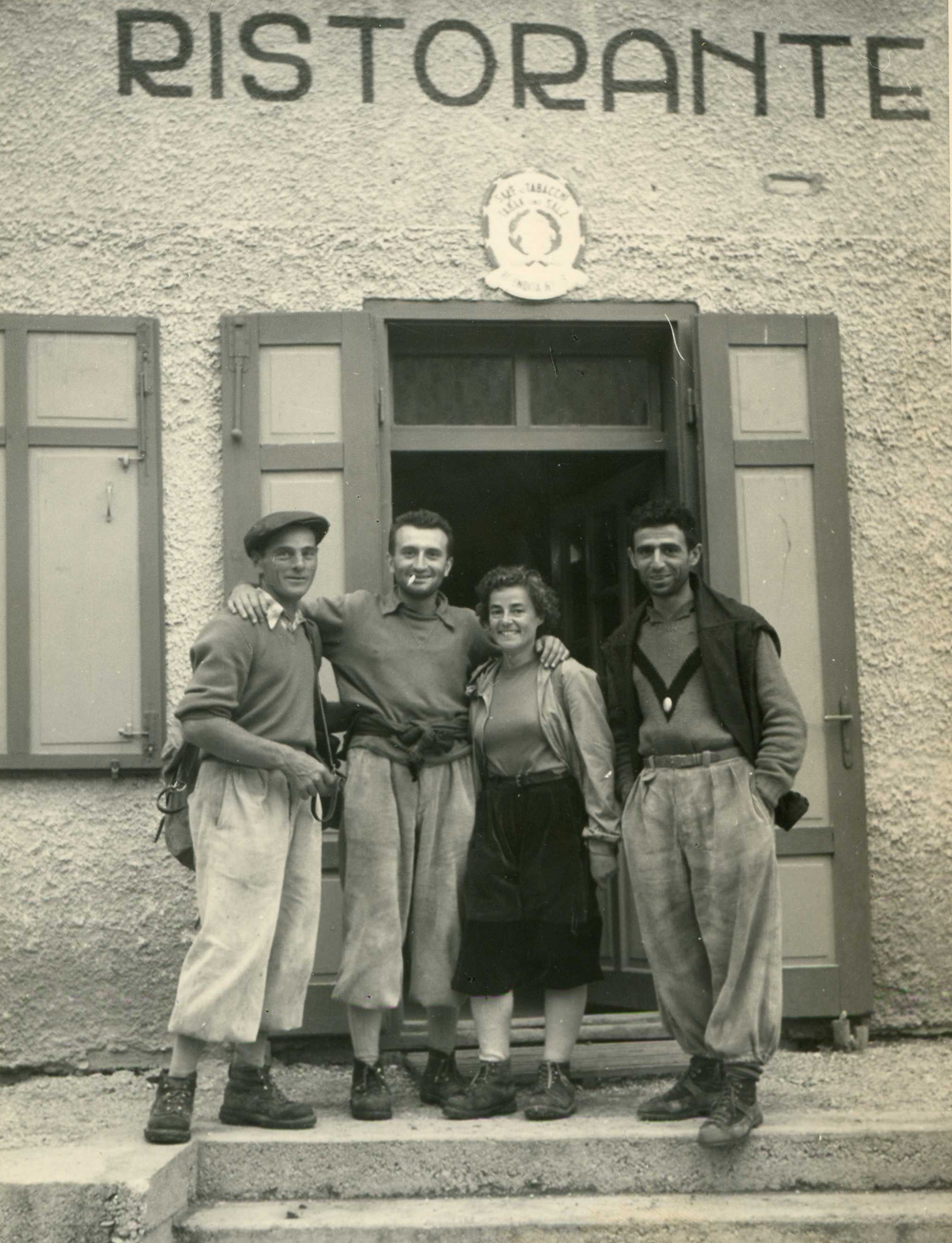
Left: Sonia in Les Calanques during the 1930s. Her climbing shoes were homemade
from sneakers with bike and truck inner tubes stuck to them. (Robert Gabriel)
Middle: ‘My Sistine chapel’, Le Grec called called his first ascent of the Su Alto, pictured
here with an inscription from Riccardo Cassin: ‘“To George Livanos who twenty years back
did open this new marvellous route, R. Cassin with his greatest regards and admiration”’
Right: From left to right: Fortunato Dalpiano, Le Grec, Sonia and Robert Gabriel outside
the rifugio following the first ascent of the Spigolo Ouest of Monte Cavallo in 1953.
In 1951, the pair really made their mark on Dolomite climbing with the first ascent of the direct on Cima su Alto, a route of sesto superior standard done without any preparation and two bivouacs. It was, Le Grec said later, ‘my Sistine chapel.’ For the next quarter of a century, Le Grec continued to climb hard new routes in the Dolomites. In 1953 for example, he and Robert Gabriel did the first ascent of the west pillar on Monte Cavallo, also known as Heiligkreuzkofel that dominates Val Badia. Reinhold Messner repeated it fifteen years later and said it was still one of the most difficult routes in the Dolomites. As the years passed, Le Grec’s haul of new routes increased: the north-west faces of Terranova and Torre del Lago; the west face of Torre Venezia; the first ascent of Castello de la Busazza; the west faces of Sciora di Fuori and the Crozzon di Brenta; the first ascent of the Torre Gilberti on the Cima Tosa.
Even today his list of first ascents is extraordinary. Above all, they were of high quality. Oh, the Livanos routes! They really were a must. Repeating them was enough to convince yourself that you were among the special ones. And they weren’t just confined to the Dolomites. He continued to climb in the Oisans and on the big limestone cliffs further west, like the Vercors. Bruno Fara, for example, one of the stars of the 1970s, wrote how the ability to do the Livanos pillar on the Archiane without a bivouac was a qualification for trying big north faces in the Alps. But his most significant contribution was in Italy. Le Grec kept track of his ascents in small notebooks and in larger ones stuck photos of big routes that he had climbed in the Alps and the Dolomites. When he finally retired in 1978 he tallied up the score. (This was a typical piece of self-mockery, by the way.) Of the 60 new routes he had climbed in the Alps, 40 were in the Dolomites.
158 THE ALPINE JOURNAL 2020
You liked the Dolomites for that also, no? Without a question? [Amy asked.]
When Gabriel gave up climbing, Le Grec’s partners, apart from Sonia, included Roger ‘Baffo’ Lepage, here belaying

Of the 242km he climbed, more than half were in the Calanques, with 500 new routes along the way, but 64km were in the Dolomites. Next, by some distance, came Chamonix, with 8.9km.
His affection for Italy was understandable. Apart from the appeal of big limestone walls, they appreciated his interest in the Dolomites and Le Grec’s sense of humour. Early in his career, journalists from the Marseille press became his fans and followed his career closely but that wasn’t repeated elsewhere in France. Yet in Italy there were a number of articles in the press and he became better known there than in his home country. And as he told Bernard Amy and Pascal Sombardier in 1984:
I had my habits. In the refuges, I had ‘my’ room. Once, I arrived, it was occupied. So, the guardian, she went to see the guy and told him: ‘You’re in room 10, but that’s Livanos’. He’s just arrived so you have to go.’ The guy said, ‘No sweat’, took all his stuff and cleared out.
No, none at all. There was no question to ask. ‘If he’s here, it’s final. How do you want the key for Room 10? With Provençal herbs or mayonnaise?’ [Laughter] It was great. The guy was in fact delighted to have slept in my room.
Ah, it’s not unpleasant. Because in France, to be sent to bed like a dog with kicks in the ass…
He was an expert aid climber, that being the big-wall technique before the free-climbing boom took hold. In his compendium of statistics, he calculated he had placed 25,000 pegs. One of his favourite aphorisms ran like this: ‘Better one more peg than one man less. Especially if that man is me.’ Free climbing, for Le Grec, meant being ‘free to do whatever one likes: put an etrier on if one feels like it, climb a grade III if one feels like it, or go pick strawberries.’ His ethical position was pragmatic, but humorously so. ‘For me, the ideal is to start from the bottom, reach the top and come back down. And not too fast.’ But as Robert Gabriel pointed out: ‘from being the champion of aid climbing, he became the champion of free climbing. Some of our routes, opened in the 1950s, are still quoted grade VI by today’s climbers.’ Le Grec himself acknowledged this transition in his frank conversation with Bernard Amy and Pascal Sombardier. The loss of prestige in aid climbing was ‘logical’, Le Grec said. How else would climbing progress? His inquisitors were unconvinced. Hadn’t he placed 25,000 pegs? That must have represented something.
'VOTE LIVANOS' 159
Yes, it represented effort, but I never thought that aid climbing was superior to free climbing. It was a means to progress when there was nothing else. Still, with guys such as Vinatzer and Comici, you had nothing to teach them. There are some moves still graded VII- put by Papi Vinatzer in 1933 And you should see what he had on his feet.
Until he got married and quit, Robert Gabriel was his rope-mate in a great number of first ascents on the breath-taking walls of northern Italy. ‘Gabriel was not a brilliant climber,’ Le Grec said, ‘but he was for me always a marvellous partner. I only have one regret, that he stopped in 1955, which undoubtedly deprived me of some nice first ascents. Afterwards, I only occasionally met another Robert Gabriel. In terms of spirit, energy, impermeability to adversity, Gabriel was the man.’ Le Grec climbed with all sorts of people, ‘around 300 guys’ according to his notebooks, and as he put it: ‘E basta!’ Regular partners after Gabriel included Marc Vaucher and Roger Lepage, who climbed with him until he stopped. But it was his wife Sonia who would be his ideal partner, always ready to follow him up the north face of the Civetta or the grand dièdre of the Cima Su Alto.
Georges met Sonia at a CAF camp in the late 1940s. Her real name was Geneviève Brès but like his hero Tartarin de Tarascon Georges was in the habit of calling all girls Sonia. Geneviève was the best of the girls climbing as well as the prettiest. Georges was the best male climber. Soon they started climbing together and from then on there was only one Sonia for Le Grec. As there were then not many women climbers at the time, Sonia accumulated the largest number of first female ascents in the Dolomites for her era. For example, in 1951 during his second season in the Dolomites, Le Grec did the fourth ascent of the north-east face of the Torre di Valgrande, which was a female first for Sonia. Many routes Le Grec repeated in the Dolomites were first female ascents for Sonia. This aspect of her climbing career went mainly unnoticed in France; Le Grec being the leader was taking all the glory. But in Italy the Dolomites climbers were astounded by this French lady who was so natural, simple and joyful and so good on the rock, even more astounded than they were by Le Grec.
160 THE ALPINE JOURNAL 2020
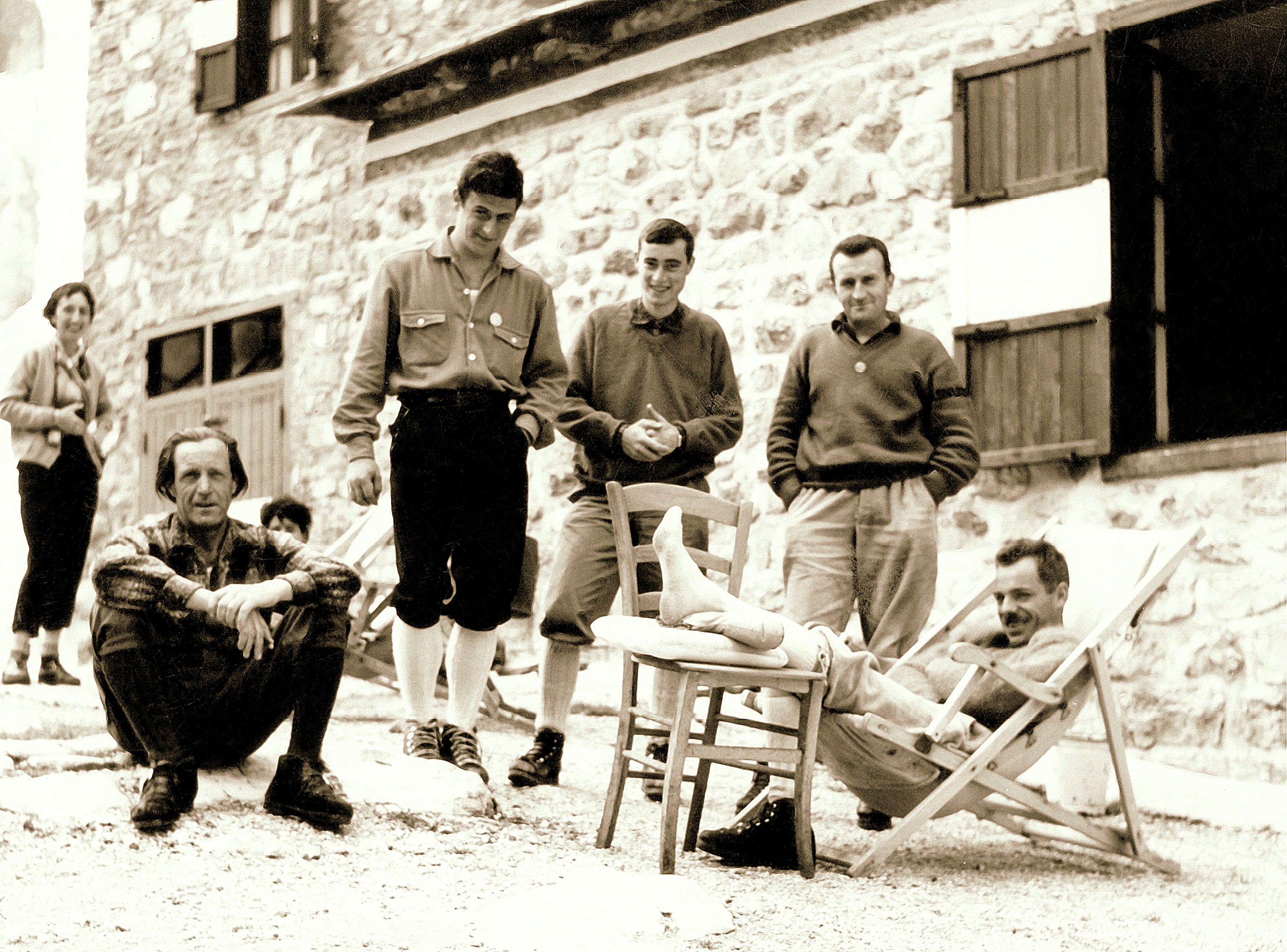
Le Grec in the Brenta, pictured here with the great Bruno Detassis, left and seated, hut guardian, philosopher, leader of the first expedition to Cerro Torre with 200 new routes in the Dolomites to his name. Roger Lepage is resting his foot.
Le Grec characterised his marriage with the same wry self-deprecation he applied to most things.
Some of my friends have envied me a companion always ready to follow me on the most overhanging adventures. Poor chaps, if only they knew! If only they understood what it is to climb day after day with a feeble woman of 4ft 11in who ignores difficulty, fatigue, cold, hunger and thirst, while HE is much sensitive to all those inconveniences! If they knew what it is, after a tough pitch of grade VI, to see HER arriving, smiling, calm, detailing the tones of a floweret on the overhang, while HE, on that same overhang… Well, forget it.
In my climbing life, I knew two exceptional female alpinists: Denise Escande, with whom I climbed; and Sonia with whom I never shared a rope because Le Grec was her leader. Even the great Gino Soldà tried to take her up a climb but in vain; Sonia only ever had one climbing partner. Those two great ladies of alpinism had this in common: they had no fear of anything and certainly not of dying. This allowed them to live their passions fully and for Sonia there were two: Le Grec and climbing, which melded so well. Le Grec showed his love in his inimitable fashion. ‘If she was a spud,’ he said, ‘I would say it… or rather I would not as I would not have married her.’ But his respect was never far away. He liked to remind his male climbing friends that when they climbed an overhang with a 10kg rucksack, that was only an eighth of their bodyweight. For Sonia, it was a quarter.
'VOTE LIVANOS' 161
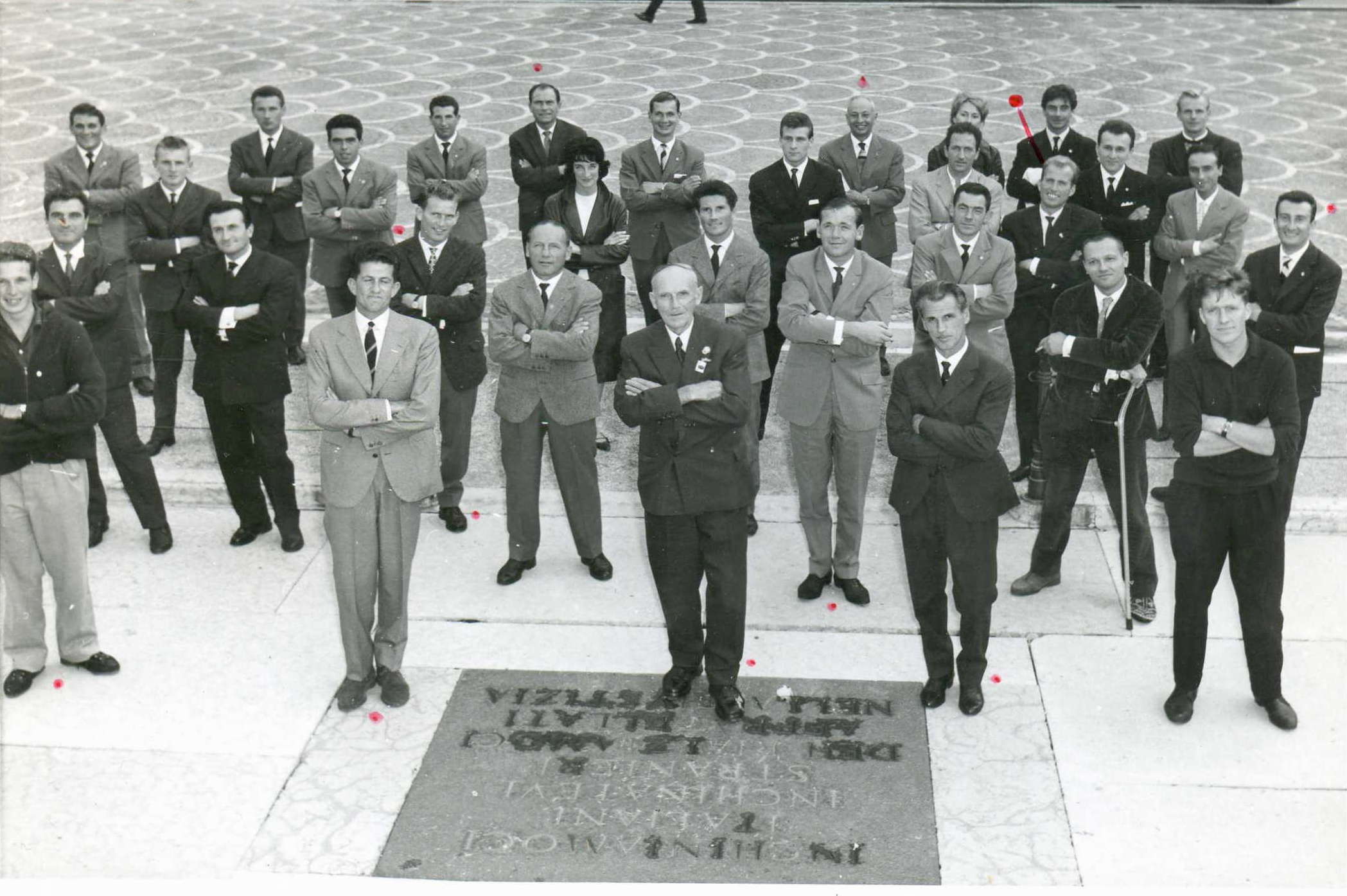
A galaxy of climbing stars at the Trento film festival in 1961. Le Grec is dressed in a black suit, standing to Gaston Rébuffatt’s right. Front row left to right: Claudio Barbier, Gaston Rébuffat, Otto Herzog, Mario Stenico, Michel Vaucher. Second row left to right: Cesare Maestri, Georges Livanos, Toni Kinshofer, Riccardo Cassin, Walter Bonatti, Toni Hiebeler, Pierre Mazeaud. Third and last row together left to right: Gigi Alippi, Aleš Kunaver, Pierliugi Airoldi, Annibale Zucchi, Giancarlo Frigeri, unknown, Yvette Vaucher, Sepp Inwyler, Pierre Marchard, René Dittert, Bepi de Francesch, Aldo Klaus, Maria Teresa De Riso, Dino De Riso, Toni Serafini, Toni Masé, John Harlin, Luciano Ghigo, Romano Merendi.
In 2002, Georges and Sonia were in Auronzo di Cadore to receive the Pelmo d’Oro Prize in recognition of their extraordinary shared career in the 1950s and 1960s. First awarded in 1997, the Pelmo d’Oro was founded to recognise the true greats who contributed to the Belluno Dolomites. The citation praised a ‘golden couple on the rocks and in life’: it was given to them equally. They were the only non-Italians to win it. Even Claudio Barbier, who besides his staggering solos put up so many new routes in the Dolomites, didn’t get it. Perhaps it was because he didn’t have Le Grec’s tchatche, his gift of the gab. Italians in the Dolomites have a soft spot for comedians and considered Le Grec one of their greatest. As for Sonia, they were bowled over by a climber with so much talent, cheek, mastered calm and kindness. You didn’t meet many like that on big walls in the Dolomites in those days.
Happily for us, the humour his Italian friends appreciated is preserved between the covers of his book Au delà de la Verticale, ‘Beyond the Vertical’, first published in 1958 and still in print, although sadly not translated into English. ‘Every community has its bible,’ the publisher Guerin said its blurb when it reissued Au delà de la Verticale. ‘This book, obviously, is one for all alpinists and climbers. Restorative, funny, cunning: it is a landmark.’ In his review for La Montagne, Jacques Teissier du Cros claimed three books as the greatest of that era: Rébuffat’s Starlight and Storm, Bonatti’s My Mountains – and Georges Livanos’ Beyond the Vertical.
162 THE ALPINE JOURNAL 2020
The book is suffused with the twang of the Marseille accent, the smell of pastis and Le Grec’s very specific sense of humour. He’s a great alpinist, and he isn’t going to hide that fact but he will have a lot of fun not taking himself at all seriously. ‘As far as advertising is concerned,’ he would say, ‘one is never better served but by oneself.’ It’s naïve to imagine that success doesn’t come without a little self-regard. His inspirations are Sancho Panza, the down-to-earth and sceptical sidekick of Don Qixote, and even more so Tartarin, from Alphonse Daudet’s novel Tartarin of Tarascon, the self-deluded hunter whose bravado lands him in an adventure he can’t handle. Honesty with oneself lies at the heart of Le Grec’s book, of his alpinism too, and his life, but it’s all masked with some preposterous clowning.
I first climbed with him in 1961, the Voie de la Écaille at La Tête de la Mounine, outside Marseille. Le Grec had done the first ascent ten years before with Robert Gabriel. He wrote our day up for an article, casting me as one of the ‘new wave’ of young climbers. The story is full of his teasing humour: he noted that with a name like ‘Vola’, or ‘flew’, he needed to keep an eye on me. ‘During the walk-in,’ he wrote, ‘I realised Eric was a swell guy. Indeed, he seemed to know one of the masterpieces of mountain literature inside out.’ Meaning of course his own book Au delà de la Verticale. We had a grand day out on baking hot rock, during which I climbed a new pitch of aid, tapping in the pegs lightly so the great man wouldn’t have to work hard to get them out. (‘What a guy!’ Le Grec wrote. ‘He does an A3 up an A1 pitch! But poor chap, what you’re supposed to do is the exact opposite.’) After that we retreated to a bar to drink. Or rather, in my case, to eat, since, as Le Grec observed, ‘He swallows a camembert as others swallow an aspirin.’ His article concluded:
Our first outing went well. There will be others, because if Eric still ignores many things, I am starting to forget many. From him, I learn once more that one must take a risk; Eric for his part will learn that it is sometimes good to hesitate. In other words, if we climb together, I will improve and he will get worse.
Two years later, in 1963, I joined him in the Dolomites and saw for myself how much Le Grec and Sonia were loved there. It was during one of the climbing camps Le Grec organised with the benevolence of Lucien Devies, his sponsor, admirer, and friend. As soon as we arrived in Belluno, we – and by ‘we’ I mean ‘him’ – were given a star’s reception. Among the Italian climbers present was Armando Da Roit, guardian of the Vazzoler refuge and the soul of the Civetta, just as Bruno Detassis was the soul of Brenta. Nicknamed Tama, Armando was a great man, later a senator in the regional government at Belluno. He smoked black Tuscans, as hard as wood and so bloody strong I couldn’t stand more than one puff without getting sick.
I started the meet climbing with the youngest of us, Henri Paul Plathey, who had just been accepted at the École Polytechnique in Paris. We did several climbs together, one with Armando, Le Grec and Sonia, the fourth ascent of Armando’s route on the Busazza. I wasn’t in great shape;
'VOTE LIVANOS' 163
Livanos and friends at the climbing camp he led at Vazzoler in 1963. Front row left to right: Jérôme Brunet, a friend of A Da Roit, Marcello Bonafede, Bepi de Francesch, Claude Deck. Back row left to right: Carla Da Roit, Eric Vola, Ottilia Da Roit, Jacques Martin, Sonia, Le Grec, Maurice Negri.
I’d spent too long under grey Welsh skies for that. Plathey wanted to climb Le Grec’s route on the Cima Su Alto and since I wasn’t prepared for a climb like that, he convinced Marcello Bonafede to go with him, much against his will. The worst storm Armando had ever seen from his Vazzoler refuge hit them soon after they crossed the Su Alto roof. They had only 180m to go but it snowed continuously for 36 hours. There was a metre of snow at the hut.
Beppi de Franchesch, Le Grec and Armando were confident in Marcello Bonafede’s ability to survive the worst conditions and after two days of storm the weather was glorious again. I woke up early and coming out of the refuge I saw Marcello returning alone with a look of despair on his face, hollow cheeked and haggard. The dump of snow had blocked their progress one pitch above the roof. They bivouacked. The following day was worse than ever, snow everywhere. Only retreat could save them. Above the roof, Plathey made the first abseil, reached the wall only with the greatest difficulty and then collapsed. He’d suffered a fatal heart attack. Imagine Bonafede’s situation, in this horrendous storm, hearing nothing from his companion and with the rope blocked. In the end, after several hours, he made it down the rope using prusik knots to reach Plathey’s body, made a pendulum with him under the roof and clipped him to a peg.
164 THE ALPINE JOURNAL 2020
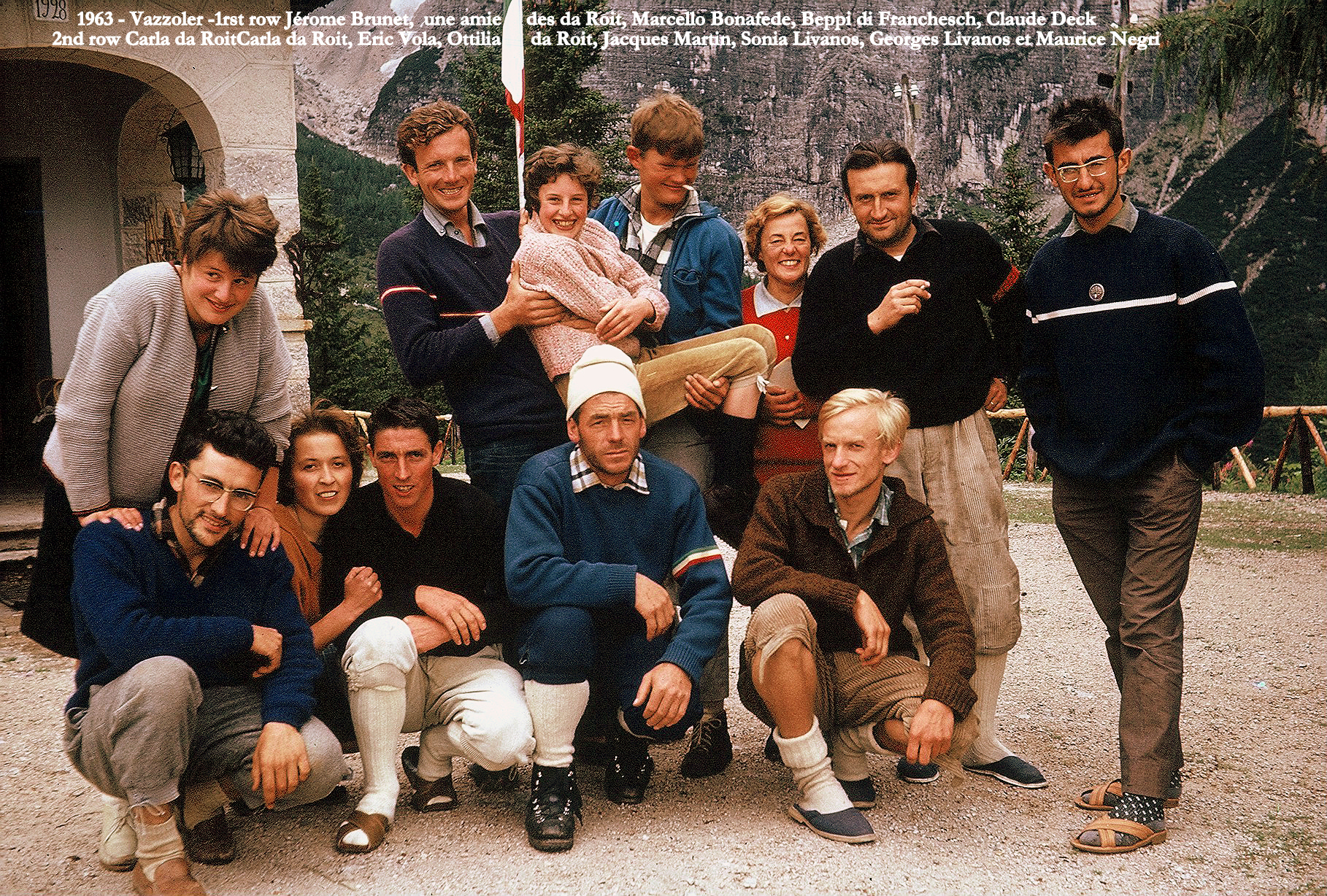
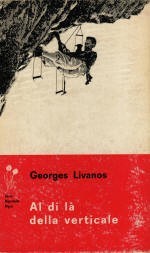
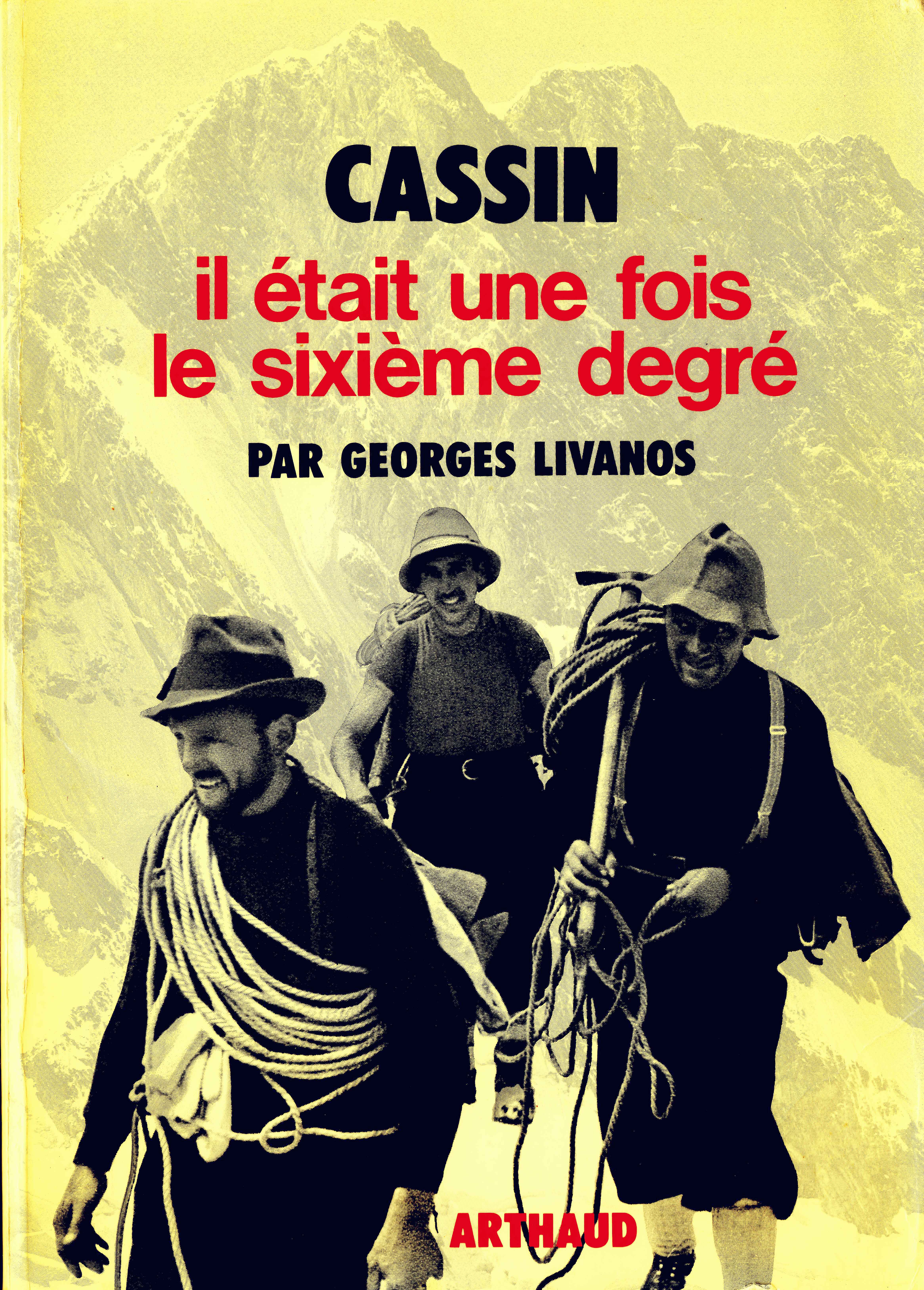
Both Le Grec’s books are highly regarded, neither are available in English: the Italian edition of Beyond the Vertical and Cassin: Once upon a Time in the Sixth Grade. Le Grec signed Vola’s copy of the latter with the following dedication: ‘To Eric Vola. Friend (for a long time and loyal, which is rare). Climber (Brilliant). Roisterer (Ditto). Smoker (Average). Boozer (Excellent). Muncher (Not bad. Hide your glasses and ties!). [Vola’s party trick was to eat wine glasses.] Bullshitter (Honourable mention).’
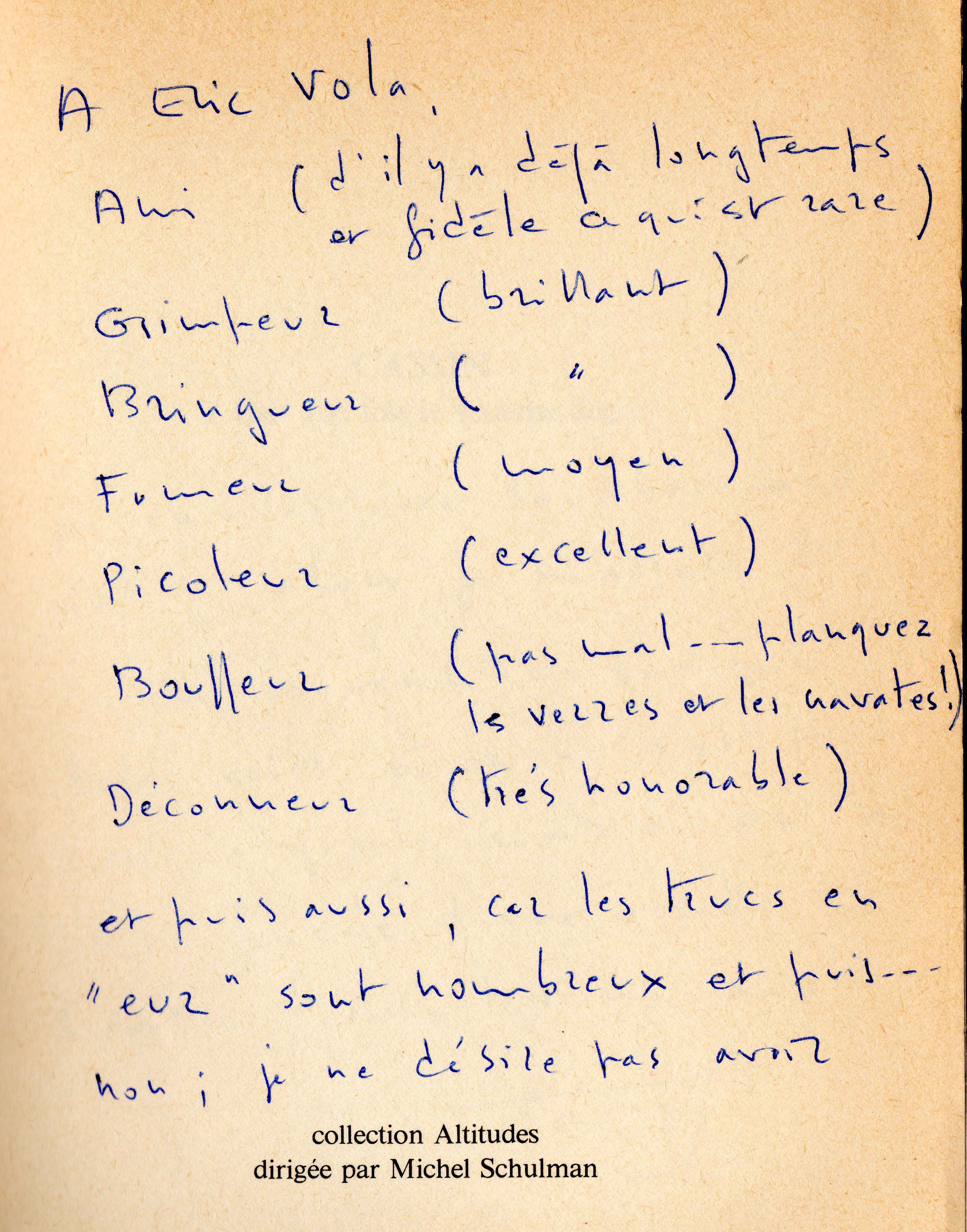
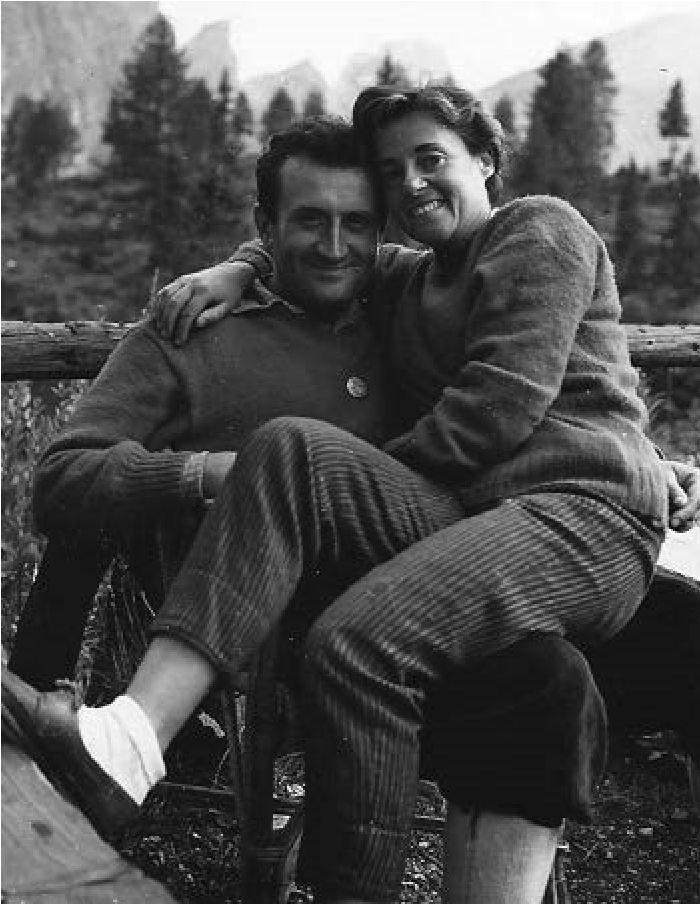
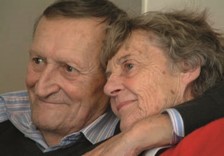
Le Grec met Geneviève Brès at a climbing camp in the late 1940s and in honour of his literary hero Tartarin de Tarascon dubbed her Sonia. They were inseparable until his death in 2004. Sonia Livanos is credited with more first female ascents in the Dolomites than any other woman of her generation. (Vinicio Stefanello)
The article came out in late 1994, as the following spring’s presidential elections that would see Jacques Chirac become president got underway. It carried the headline: ‘Vote Livanos’. Audouard was not a climber and admitted that he was irritated by some ‘conquerors of the useless’ who sometimes take advantage of their lofty position to look down on those condemned to live the humdrum life of ‘métro-boulot-dodo’, or ‘Tube-worksleep’. And for those millions facing the challenge of unemployment, the challenge of the mountains must seem irrelevant. Their ‘dodo’, he wrote, is filled with nightmares and distress. But still, Audouard goes on, they must have enjoyed seeing Le Grec. ‘In his eyes there is all the irony and humour of someone who climbed his whole life without treading on anyone else, who never looked to amaze anyone, certainly not himself. When asked who is the best alpinist, he answers with hesitation: “The oldest.”’ For Audouard, Le Grec offered a sharp contrast to politicians offering voters the world:
The sight of a happy man who did not achieve his happiness at the expense of others ... that sort of happiness even the unfortunate are able to share. He offers an uplifting message during this election season. Right now the political spiders are in a frenzy to get into power, distributing kicks with their feet in the teeth and gums of their opponents. It seemed to me essential to talk to you about a man who did not become a star but instead became a master. He never ceased to be himself and never had any other ambition than to find happiness on earth: for himself and for others.
'VOTE LIVANOS' 167
Le Grec died in 2004 aged 81. Fourteen years later, Sonia left us as well. She was 94 years old and had decided it was time to catch up with him.
Sonia and Le Grec were happiness itself, to all those who met them and to those who became their friends. One might have feared that after Le Grec’s departure, Sonia would not be the same. This did not seem the case, and if it was, she never let it show. Her joie de vivre remained intact, as did her pleasure in the company of friends, particularly when she could speak of her Grec. During her last few years she was in a care home where, as her nephew Jean-François said nicely at her funeral, ‘her memory slipped away.’ Our meetings were always joyful and cheerful. For her, Le Grec was by then alive and always near. Many times, when we went to see her, she asked if we had seen Georges who had just gone to get the newspapers.
Sonia would not have allowed sadness at her passing. Jean-François told me that during one of his last visits, she asked him to lend him his walking stick. Astonished, because she never had any need for one, he asked her why: ‘To hit those nurses who continually bother me!’ Until the moment she left us, she remained the free soul she always had been.
External Links
Eric Vola has a website about the life of Georges Livanos at https://sites. google.com/site/georgeslivanos/Accueil. Jean Afanassieff’s film on Le Grec is on YouTube.
There is also a good French entry on Wikipédia. For more information on Le Pelmo d’Oro:
https://sites.google. com/site/georgeslivanos/lepelmod%27oro.
So Le Grec did not start climbing in the Calanques but in the Alps and specifically the Mont Blanc range. At age 13, Georges climbed his first summit, the Aiguille du Tour, with his parents and the guide Alfred Burnet. In the following two summers, his father hired Ulysse Simond to guide Georges on classic easy routes. Georges was talented enough as a rock climber to be selected by Armand Charlet during the Fête des Guides in 1938 to demonstrate how to climb the Grande Arête on the Gaillands crag. He was then 15 years old.
Back in Marseille, climbing now obsessed him. His parents made sure Georges joined the CAF in 1939. If the boy were determined to climb, it would be in the company of known personalities and alpinists they had met and climbed with in Chamonix: the Marquise d’Albertas and Jean Save de Beaureceuil, both members of the GHM. His parents asked them not to let him take the lead but it wasn’t long before Le Grec would disobey his father, as he wrote in his memoir Au-delà de la Verticale:
… one day, our leader failed on a pitch because of a bruised wrist; he came down and asked me to go and fetch the peg he had left. Reaching the peg, I saw above me beautiful grey slabs… too tempting. Madame d’Albertas saw what I was up to only as I finished the pitch. She was a little worried, not that much though, as in the ‘gang’ everyone was more or less leading and my father’s fears made them smile. It was one of the great joys of my life.
Soon Georges was adding new routes and the legend was born: in 1941 he put up 24 of which La Centrale was the longest grade six in the Calanques and the Yellow Wall, climbed with Gaston Rébuffat, was the toughest aided climb for quite some time. In 1942, he climbed 28 new routes, of which the highlight was the second ascent of Pilier de Bertagne, dubbed the Walker Spur of the Marseillais and only just climbed by Robert and Suzanne Tanner. (Le Grec considered Robert as the best climber he had known, but unfortunately Robert stopped soon afterwards.) Georges then added his own new route to its left, La Plaque.
In April 1943, he joined the Camps de Jeunesse et Montagne, as Le Grec put it 'an ersatz military service in an ersazt time'. Already this year he had done 15 new routes and become the best climber in the Calanques, by far
Georges ‘Le Grec’ Livanos, after a cold, wet bivouac in the Dolomites.
I was 18 years old when I met Georges ‘Le Grec’ Livanos in the Calanques.
In many ways he became my master and my mentor. I was absolutely a fan, and not just of Le Grec but also of Sonia, his wife and climbing partner. He honoured me with his friendship and we remained close until his death in 2004. Every time I had the chance to go back to the Calanques, I would climb with him and his group of friends, sometimes participating in one of his many first ascents. He was a happy man who shared his joie de vivre with everyone who came near him. But I hesitated for a long time, almost three years, before accepting this invitation to write about him in English. How could I do him justice? How could I make a British climbing audience appreciate his unique appeal when almost all are unaware of Le Grec and his deeds? Then I thought of Don Whillans and something Doug Scott said at the funeral of Jean Afanassieff, or ‘Afa’ as he was known.
152 THE ALPINE JOURNAL 2020
Climbing with his parents in Chamonix.
In the course of climbing with English climbers such as Roger Baxter-Jones, Brian Hall, Alan Rouse and Andy Parkin, [Afa] did a lot for the entente cordiale. He joined our Karakoram expedition of 1983 of which he was a very popular member, even with Don Whillans who wasn’t that keen on foreigners and affectionately called Jean ‘Have-a-sniff’. Jean called Don ‘un rosbif’.
In defence of Afa, it was I who taught him rosbif, when he was 17 and living in Paris. He knew both Don and Le Grec, and so I imagined him introducing Le Grec to Don. Just as they both liked Afa, I know that Don and Georges would have enjoyed each other’s company. Both men were larger than life. Le Grec liked to quote Sir Francis Younghusband on the schoolmaster Bentley Beetham, from The Epic of Mount Everest: ‘The kind of man that nothing less than a ton of bricks could keep down: nineteen hundredweight would have been of no use.’ Both of them were like that. Both had an instinct for quick repartee. Le Grec had a knack for aphorisms: ‘Big adventures make short careers,’ he suggested, and ‘There’s no such thing as bad rock, just bad climbers.’
When he first met Lucien Devies, that titan of the French mountaineering establishment, someone introduced Le Grec as ‘the best Calanques climber’. Le Grec stepped forward, hand outstretched: ‘The best,’ he said, ‘and the most modest.’ Such humour might have been wasted on Devies. As he used to say himself: ‘If you want to make it funny, talk to someone else.’ On the other hand, they became good friends, sharing a correspondence for over 40 years. In 1972 Le Grec was writing to Devies about his attempt, in his fiftieth year, on a new route on the west face of the Moiazza, close to the Civetta, with a gang of young Italians, ‘fans’ he called them, from Agordo. He told Devies:
Three long days of preparation and the attempt was stopped by two of my three companions’ tiredness. The last one, the young guide Gianni Costantini, was up for it, but we could not abandon the two others. Seven 40 m abseils … and basta. We had climbed ten pitches. After that? Bad weather, bad weather, a female friend killed in a car crash, my holiday finished, I went back home. We will climb the pillar next year. On 21 August Gianni Costantini was killed in the mountains. So what next? What next? [It’s my] target for 1973! I will avenge Gianni. This ‘old bloke’ will return to battle (I had an immense liking of Gianni) to avenge his young friend, to avenge himself, for he is the Greek …
Then he could get the rope down but had to bivouac a second time. On the third day, at last, he reached Vazzoler.
For Beppi and Armando, it was out of the question to do as they would in Cortina, abseil down and throw the body off the wall. With Le Grec’s help, they organised a rescue to return Plathey to his family intact. Beppi asked 10 of his friends, mountain soldiers from Canazei to join us. With their help, Le Grec and Armando organised zip-lines on the lower 400m section of the wall. Meanwhile, Bonafede, who wanted to be first to reach his companion’s body, climbed with Beppi towards the roof. Meanwhile Bonafede’s best friend, Natalino Ménégus and I paid out a specially long rope from the foot of the corner as they made progress towards the body, some 190m above our heads.
By the end of that day, everything was ready to get Plathey’s body down. We had to heave on 30m of slack before we felt his body on the rope and 100m down it stuck in the middle of the wall on a small ledge. We had no choice but to go down to the Tissi hut for the night and come back next morning. This time four of us pulled more than 40m of slack before the body came free. At least the final part went smoothly. The zip-lines Le Grec had organised with Beppi’s friends were professional work. Then we carried Plathey’s body from the Tissi hut to Vazzoler, before going on down to Agordo where Plathey’s elder brother was waiting. We came across a priest with his flock who raised his camera to take a picture. Furious, Armando, without removing the Tuscan from his mouth, tore the camera from the priest’s hands and crushed it on a rock. You can see why local people asked him to become their senator.
'VOTE LIVANOS' 165
Thanks to Armando, Le Grec and the others, Paul Plathey’s parents were able to see their son for the last time in a presentable state. It was not much, but at least we had managed something. Compared to how rescue worked in Chamonix in those days, I felt proud to have been part of this group of benevolent alpinists who did not hesitate to give a full week of their time to take down a dead body and without asking any compensation. So, I started to smoke Tuscans to imitate Armando, but the green ones, which weren’t as strong, and in Belluno I bought a red pullover with a black V, like the one Le Grec wore.
I was always broke in those days because my mother couldn’t stand me running off to the Alps. Sonia reminded me that I borrowed money from Bonafede and that Le Grec had to telephone my mother to be reimbursed, since this ‘loan’ was a big amount for a young guide like Marcello on a modest income. I also borrowed money from Le Grec at the railway station to buy some comics for the journey home. When he saw me coming back, he said to Sonia: ‘Look what this nit has done with my money!’ We didn’t share the same literary interests. I must confess Preuss was not my cup of tea, in contrast to Le Grec who had an encyclopaedic knowledge of mountain literature, having read Sir Francis Younghusband’s The Epic of Mount Everest as a student.
In 1978, aged 55, Le Grec stopped climbing altogether. He liked to quote one of Tartarin’s companions: ‘The eagle doesn’t hunt flies.’ As he wrote in a new edition of Au delà de la Verticale: ‘One day, I wrote to Robert Paragot: ‘When you have hunted lions, rabbits look meagre.’ And I must also quote Robert Gabriel: ‘If I killed myself in the Calanques or on easy ground, I wouldn’t dare go out again.’ When Bernard Amy and Pascal Sombardier asked him about his retirement, he was a little more serious but no less sanguine. ‘It was tiring me more. So, I preferred to stop with good memories, rather than memories of grade IV, then III. When one climbs, one must climb well, or not at all. Brasillach has said “youth adorns everything it does. Wanting to prolong it, one risks ending as a parody.”’ They wondered why the climbing world no longer heard from him. ‘It’s not modesty,’ he told them, with a smile. ‘It’s a matter of pride. The ass on Olympus. You’re lucky, you can put me in your autograph book.’ As for getting involved in one of French climbing’s institutions, he almost choked with laughter. ‘As [the French comedian] Coluche said, “The last man to see me work, he’s old.” No, the climbing was over and his long retirement beckoned.
The world had not heard the last from Le Grec though. In 1994, Jean Afanassieff made a film about him that was aired as part of the series ‘Sunday in France’. As it happened, Yvan Audouard, a well-known humourist and television critic for Le Canard Enchainé, was watching. Audouard was a man from the south, like Le Grec, who had coined the aphorism: ‘Heureux les fêlés... car ils laisseront passer la lumière.’ (‘Blessed are the cracked, for they let in the light.’) Although Le Grec was the subject of a number of articles in the national press, Audouard’s article was the best tribute a journalist paid to my hero, not least because he didn’t know him. He simply went by what he saw.
166 THE ALPINE JOURNAL 2020